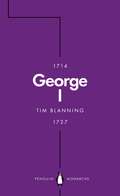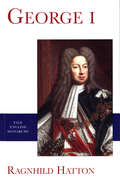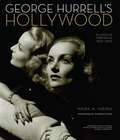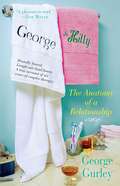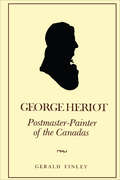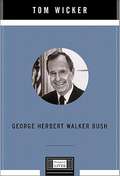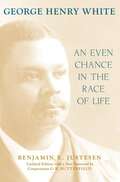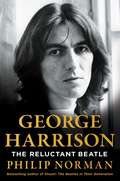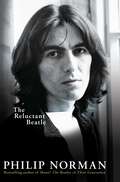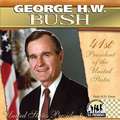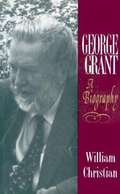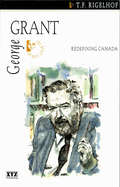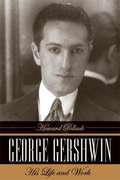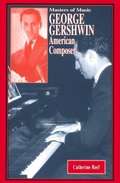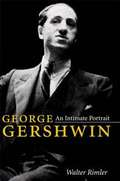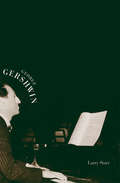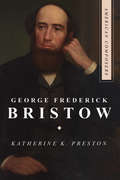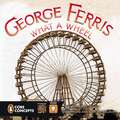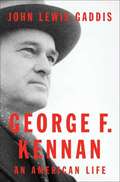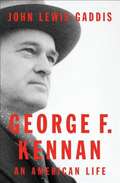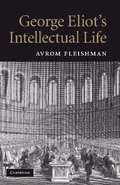- Table View
- List View
George I: The Lucky King (Penguin Monarchs)
by Tim BlanningGeorge I was not the most charismatic of the Hanoverian monarchs to have reigned in England but he was probably the most important. He was certainly the luckiest.Born the youngest son of a landless German duke, he was taken by repeated strokes of good fortune to become, first the ruler of a major state in the Holy Roman Empire of the German Nation and then the sovereign of three kingdoms (England, Ireland and Scotland). Tim Blanning's incisive short biography examines George's life and career as a German prince, and as King. Fifty-four years old when he arrived in London in 1714, he was a battle-hardened veteran, who put his long experience and deep knowledge of international affairs to good use in promoting the interests of both Hanover and Great Britain. When he died, his legacy was order and prosperity at home and power and prestige abroad. Disagreeable he may have been to many, but he was also tough, determined and effective, at a time when other European thrones had started to crumble.
George I
by Ragnhild HattonIn 1714 George Ludwig, the fifty-eight-year-old elector of Brunswick-Luneburg, became, as George I, the first of the Hanoverian dynasty to rule Britain. Until his death in 1727 George served as both elector of Hanover and British monarch. An enigmatic figure whose real character has long been concealed by anti-Hanoverian propaganda, George emerges in this groundbreaking biography as an impressive ruler who welcomed the responsibilities the accession brought him and set out to bring culture to what he considered the unsophisticated English nation.Ragnhild Hatton's biography is the only comprehensive account of George's life and reign. It draws on a wide range of archival sources in several languages to illuminate the fascinating details of George's early life and dynastic crises, his plans and ambitions for the British nation, the impact of his rationalist ideas, and his accomplishments as king. The book also examines the king's private life, his family relationships in both Prussia and England, his private interest in music and the arts, and the improvement of his British and Hanoverian properties.
George Hurrell's Hollywood: Glamour Portraits 1925-1992
by Mark A. Vieira Sharon StoneFabulous montage of new insights, new portraits, and behind-the-scenes stories spanning Hurrell's entire career.
George & Hilly: The Anatomy of a Relationship
by George GurleyA funny and intimate portrait of a relationshipgleaned from the author and his fianceé's couple's therapy sessions. After roughly three-and-a-half years of dating his girlfriend Hilly, New York Observer nightlife and society reporter George Gurley decided that it was time to get married. Well, engaged. No rush. One day at a time. George had witnessed New York husbands --frail, meek, ashamed, and henpecked, pushing double wide strollers as their battle-ax wives babbled on about "dinner with friends"--and it wasn't for him. Enter Dr. Selman: psychiatrist, obliging listener, and unwitting participant in George's own journalistic project--a no-holds-barred portrait of intimacy taken from transcripts of the couple's therapy sessions. George can be compared to a Carrie Bradshaw 2.0; that is, if Carrie were a hard drinking, ill-reputed man-about-town writing frankly about sex, love, marriage, and his own psychological baggage. Hilarious, thought-provoking, and compelling, George & Hilly reveals the uncensored, unselfconscious psyche of a man on the brink of matrimony.
George & Hilly: Anatomy of a Relationship
by George GurleyLongtime New York nightlife reporter and humor columnist George Gurley at last tells the complete and outrageously humorous story of how he and his girlfriend, Hilly, attempted--with the occasionally bemused assistance of the couples psychiatrist they are seeing--to analyze a relationship poised on the brink of commitment. George has a great many qualms about marriage. But after more than three years of dating Hilly, he's equally sure that she is the only woman in the world for him. Perhaps it's finally time for a march down the aisle. Well . . . for an engagement ring. Maybe. Or not. Fresh from what he and Hilly are terming The Big Fight--a tentative discussion of a future together--George is eager for insight on whether he's finally ready (after twenty years) to scale back his bar-hopping, party boy Manhattan life for the love of one fascinating woman. Ever the writer, George conceives a bold plan. He and Hilly will participate in therapy with Dr. Harold Selman, and George will tape-record the sessions. Six years of intensive therapy with Dr. Selman--combined with innumerable mandated "discussions" (read: more squabbling) on their own watch--force these two mismatched but undefeated soul mates to evolve into quasi semi-adults. Wise-ass, confessional, always compelling, George & Hilly is a story of sex, love, money, and big-city life . . . and of a loveable (and loving) train wreck of a couple who refuse to call their relationship quits just because they've hit a few bumps.
George Heriot: Postmaster-Painter of the Canadas
by Gerald FinleyGeorge Heriot (1759-1839), a Scot, is best known as a skilled landscape watercolourist and as the contentious deputy postmaster general of British North America from 1800 to 1816. He was also a travel writer (his Travels through the Canadas was published in 1807) and a poet. In this volume, a combination of biography and art history, Gerald Finley presents, for the first time, a rounded picture of Heriot, revealing his motives and ideals while also illuminating the texture of life in Canada during the early years of settlement. In describing Heriot's several roles as artist, administrator, patriot, spy, Finley presents a portrait of an eighteenth-century gentleman whose superficial desires were for an active public life but whose deeper yearnings were for a life of contemplation. As a member of the gentry it was natural that Heriot found his way into public service, for which he was suited both by education and by upbringing. Nevertheless, his public career did not always run smoothly and it ended in frustration and sadness. However, through his writing and especially his art Heriot found welcome relief from the tensions of his public duties. Indeed, Heriot's chief importance lies in his art. Trained as a topographical artist, he was an important exponent of the picturesque landscape. As a mode of vision the Picturesque furnished him with a special way of looking at recording the Canadian scene – to him Canada possessed the qualities of Arcadia. This viewpoint served both as aesthetic consolation and as stimulus to inspiration. This volume serves to recognize Heriot's artistic achievement and to accord him the place he deserves in the history of Canadian art and of the country itself.
George Herbert Walker Bush
by Tom WickerNo one is more qualified to give a fully rounded, objective portrait of our forty-first president than Tom Wicker. A political correspondent for The New York Times for more than thirty years, Wicker was a first-hand witness to and reporter of George H. W. Bush’s political rise and presidential reign. In George Herbert Walker Bush, Wicker provides a richly drawn and succinct overview of Bush from his New England roots, his decorated service in World War II, and his successful oil businesses to his shift to politics and rapid rise within the Republican party. As he describes changes within the Republican party in recent decades, Wicker charts Bush’s career, including in-depth analysis of his campaign tactics and his gift for creating friendships and inspiring loyalty which, Wicker argues, has been the key to Bush’s success. The result is a fascinating, timely glimpse into one of the most powerful families in America today, complete with insights into the current reign of George W. Bush, the continued legacy of the Bush family, and contemporary American politics. .
George Herbert Walker Bush
by Tom WickerNo one is more qualified to give a fully rounded, objective portrait of our forty-first president than Tom Wicker. A political correspondent for The New York Times for more than thirty years, Wicker was a first-hand witness to and reporter of George H. W. Bush's political rise and presidential reign. In George Herbert Walker Bush, Wicker provides a richly drawn and succinct overview of Bush from his New England roots, his decorated service in World War II, and his successful oil businesses to his shift to politics and rapid rise within the Republican party. As he describes changes within the Republican party in recent decades, Wicker charts Bush's career, including in-depth analysis of his campaign tactics and his gift for creating friendships and inspiring loyalty which, Wicker argues, has been the key to Bush's success. The result is a fascinating, timely glimpse into one of the most powerful families in America today, complete with insights into the current reign of George W. Bush, the continued legacy of the Bush family, and contemporary American politics.
George Henry White: An Even Chance in the Race of Life (Southern Biography Series)
by Benjamin R. Justesen G. K. ButterfieldAlthough he was one of the most important African American political leaders during the last decade of the nineteenth century, George Henry White has been one of the least remembered. A North Carolina representative from 1897 to 1901, White was the last man of his race to serve in the Congress during the post-Reconstruction period, and his departure left a void that would go unfilled for nearly thirty years. At once the most acclaimed and reviled symbol of the freed slaves whose cause he heralded, White remains today largely a footnote to history. In this exhaustively researched biography, Benjamin R. Justesen rescues from obscurity the fascinating story of this compelling figure's life and accomplishments.The mixed-race son of a free turpentine farmer, White became a teacher, lawyer, and prosecutor in rural North Carolina. From these modest beginnings he rose in 1896 to become the only black member of the House of Representatives and perhaps the most nationally visible African American politician of his time. White was outspoken in his challenge to racial injustice, but, as Justesen shows, he was no militant racial extremist as antagonistic white democrats charged. His plea was always for simple justice in a nation whose democratic principles he passionately loved. A conservative by philosophy, he was a dedicated Republican to the end. After he retired from Congress, he remained active in the fight against racial discrimination, working with national leaderas of both races, from Booker T. Washington to the founders of the NAACP. Through judicious use of public documents, White's speeches, newspapers, letters, and secondary sources, Justesen creates an authoritative and balanced portrait of this complex man and proves him to be a much more effective leader than previously believed.
George Harrison: The Reluctant Beatle
by Philip NormanFrom the premiere Beatles biographer—author of the New York Times bestseller John Lennon: The Life and the million-copy selling Shout!: The Beatles in Their Generation—a rare and revealing portrait of George Harrison, the most misunderstood and mysterious Beatle, based on decades-long research and unparalleled access to inside sources.Despite being hailed as one of the best guitarists of his era, George Harrison, particularly in his early decades, battled feelings of inferiority. He was often the butt of jokes from his bandmates owing to his lower-class background and, typically, was allowed to contribute only one or two songs per Beatles album out of the dozens he wrote. Now, acclaimed Beatles biographer Philip Norman examines Harrison through the lens of his numerous self-contradictions. Compared to songwriting luminaries John Lennon and Paul McCartney he was considered a minor talent, yet he composed such masterpieces as &“While My Guitar Gently Weeps&” and &“Here Comes the Sun,&” and his solo debut album &“All Things Must Pass&” achieved enormous success, appearing on many lists of the 100 best rock albums ever. Modern music critics place him in the pantheon of sixties guitar gods alongside Eric Clapton, Jimi Hendrix, Keith Richards, and Jimmy Page. Harrison railed against the material world yet wrote the first pop song complaining about income tax. He spent years lovingly restoring his Friar Park estate as a spiritual journey, but quickly mortgaged the property to help rescue a film project that would be widely banned as sacrilegious, Monty Python&’s Life of Brian. Harrison could be fiercely jealous, but not only did he stay friends with Eric Clapton when Clapton fell in love with Harrison&’s wife, Pattie Boyd, the two men grew even closer after Clapton walked away with her. Unprecedented in scope and filled with numerous color photos, this rich biography captures George Harrison at his most multi-faceted: devoted friend, loyal son, master guitar player, brilliant songwriter, cocaine addict, serial philanderer, global philanthropist, student of Indian mysticism, self-deprecating comedian, and, ultimately, iconic artist and man beloved by millions.
George Harrison: The Reluctant Beatle
by Philip NormanFrom the author of the million-copy selling Shout!: The Beatles in Their Generation and the bestselling John Lennon: The Life comes a revealing portrait of George Harrison, the most undervalued and mysterious Beatle. Despite being hailed as one of the best guitarists of his era, George Harrison, particularly in his early decades, battled feelings of inferiority. He was often the butt of jokes from his bandmates owing to his lower-class background and, typically, was allowed to contribute only one or two songs per Beatles album out of the dozens he wrote. Now, acclaimed Beatles biographer Philip Norman examines Harrison through the lens of his numerous self-contradictions. Compared to songwriting luminaries John Lennon and Paul McCartney he was considered a minor talent, yet he composed such masterpieces as &‘While My Guitar Gently Weeps&’ and &‘Here Comes the Sun&’, and his solo debut album &‘All Things Must Pass&’ achieved enormous success, appearing on many lists of the 100 best rock albums ever. Modern music critics place him in the pantheon of Sixties guitar gods alongside Eric Clapton, Jimi Hendrix, Keith Richards and Jimmy Page. Harrison railed against the material world yet wrote the first pop song complaining about income tax. He spent years lovingly restoring his Friar Park estate as a spiritual journey, but quickly mortgaged the property to help rescue a film project that would be widely banned as sacrilegious, Monty Python&’s Life of Brian. Harrison could be fiercely jealous, but not only did he stay friends with Eric Clapton when Clapton fell in love with Harrison's wife, Pattie Boyd, the two men grew even closer after Clapton walked away with her.Unprecedented in scope and filled with numerous colour photos, this rich biography captures George Harrison at his most multi-faceted: devoted friend, loyal son, master guitar-player, brilliant songwriter, cocaine addict, serial philanderer, global philanthropist, student of Indian mysticism, self-deprecating comedian and, ultimately, iconic artist and man beloved by millions.
George H.W. Bush (The United States Presidents)
by Heidi M.D. ElstonIn addition, his family and personal life, as well as his retirement years a disaster-relief fundraiser is highlighted. Easy-to-read text details Bush's military service during World War II and his political career as a member of the U.S. House of Representatives, U.S. ambassador to the United Nations, chairman of the Republican National Committee, chief U.S. liaison to China, director of the CIA, and vice president.
George H. W. Bush: Forty-first President Of The United States
by Rebecca StefoffExamines the childhood, education, employment, and political career of the forty-first president.
George Grant: A Biography
by William ChristianThis book sheds light on Grant's early intellectual interests, the centrality of his pacifism, his struggle to educate himself as a philosopher (he studied history at Queen's University and law at Oxford), his ambivalent relationship to organized religion, his quarrels with York and McMaster Universities, and his attitude to John Diefenbaker.
George Grant
by T. F. RigelhofGeorge Grants Lament for a Nation led some to call him a Red Tory and the dominant force behind the Canadian nationalist movement of the 1970s. Today, reading George Grants books helps us to understand the full implications of American-led, technology-driven globalization on everyday life.
George Gershwin: His Life and Work
by Howard PollackThis comprehensive biography of George Gershwin (1898-1937) unravels the myths surrounding one of America's most celebrated composers and establishes the enduring value of his music. Pollack's lively narrative describes Gershwin's family, childhood, and education; his early career as a pianist; his friendships and romantic life; his relation to various musical trends; his writings on music; his working methods; and his tragic death at the age of 38.
George Gershwin: American Composer
by Catherine ReefTraces the life of the American Jewish composer who created a new kind of music that has lasted beyond the fashion of his time.
George Gershwin: An Intimate Portrait (Music in American Life)
by Walter RimlerGeorge Gershwin lived with purpose and gusto, but with melancholy as well, for he was unable to make a place for himself--no family of his own and no real home in music. He and his siblings received little love from their mother and no direction from their father. Older brother and lyricist Ira managed to create a home when he married Leonore Strunsky, a hard-edged woman who lived for wealth and status. The closest George came to domesticity was through his longtime relationship with Kay Swift. She was his lover, musical confidante, and fellow composer. But she remained married to another man while he went endlessly from woman to woman. Only in the final hours of his life, when they were separated by a continent, did he realize how much he needed her. Fatally ill, unprotected by (and perhaps estranged from) Ira, he was exiled by Leonore from the house she and the brothers shared, and he died horribly and alone at the age of thirty-eight. Nor was Gershwin able to find a satisfying musical harbor. For years his songwriting genius could be expressed only in the ephemeral world of show business, as his brilliance as a composer of large-scale works went unrecognized by highbrow music critics. When he resolved this quandary with his opera Porgy and Bess, the critics were unable to understand or validate it. Decades would pass before this, his most ambitious composition, was universally regarded as one of music's lasting treasures and before his stature as a great composer became secure. In George Gershwin: An Intimate Portrait, Walter Rimler makes use of fresh sources, including newly discovered letters by Kay Swift as well as correspondence between and interviews with intimates of Ira and Leonore Gershwin. It is written with spirited prose and contains more than two dozen photographs.
George Gershwin
by Larry StarrIn this welcome addition to the immensely popular Yale Broadway Masters series, Larry Starr focuses fresh attention on George Gershwin's Broadway contributions and examines their centrality to the composer's entire career. Starr presents Gershwin as a composer with a unified musical vision--a vision developed on Broadway and used as a source of strength in his well-known concert music. In turn, Gershwin's concert-hall experience enriched and strengthened his musicals, leading eventually to his great "Broadway opera,"Porgy and Bess. Through the prism of three major shows--Lady Be Good(1924),Of Thee I Sing(1931), andPorgy and Bess(1935)--Starr highlights Gershwin's distinctive contributions to the evolution of the Broadway musical. In addition, the author considers Gershwin's musical language, his compositions for the concert hall, and his movie scores for Hollywood in the light of his Broadway experience.
George Frederick Bristow: Symphony No. 2 In D Minor, Op. 24 ( Jullien ) (American Composers)
by Katherine K. PrestonAs American classical music struggled for recognition in the mid-nineteenth century, George Frederick Bristow emerged as one of its most energetic champions and practitioners. Katherine K. Preston explores the life and works of a figure admired in his own time and credited today with producing the first American grand opera and composing important works that ranged from oratorios to symphonies to chamber music. Preston reveals Bristow's passion for creating and promoting music, his skills as a businessman and educator, the respect paid him by contemporaries and students, and his tireless work as both a composer and in-demand performer. As she examines Bristow against the backdrop of the music scene in New York City, Preston illuminates the little-known creative and performance culture that he helped define and create. Vivid and richly detailed, George Frederick Bristow enriches our perceptions of musical life in nineteenth-century America.
George Ferris, What a Wheel! (Penguin Core Concepts)
by Barbara LowellHave you ever ridden a Ferris wheel? You go up, up, up and can see for miles! But when the inventor of the Ferris wheel, George Ferris, first pitched the idea, everyone thought he was crazy. A 250-foot bicycle wheel that goes around and around and carries people in train cars? Can't be done, they said. But George proved them wrong. Read about how George's hard work, courage, and imagination created one of the most famous fair rides today.George Ferris, What a Wheel covers the concepts Imagination and Problem Solving.
George F. Kennan: An American Life
by John Lewis GaddisSelected by The New York Times Book Review as a Notable Book of the Year. Drawing on extensive interviews with George Kennan and exclusive access to his archives, an eminent scholar of the Cold War delivers a revelatory biography of its troubled mastermind. In the late 1940s, George Kennan wrote two documents, the "Long Telegram" and the "X Article," which set forward the strategy of containment that would define U.S. policy toward the Soviet Union for the next four decades. This achievement alone would qualify him as the most influential American diplomat of the Cold War era. But he was also an architect of the Marshall Plan, a prizewinning historian, and would become one of the most outspoken critics of American diplomacy, politics, and culture during the last half of the twentieth century. Now the full scope of Kennan's long life and vast influence is revealed by one of today's most important Cold War scholars. Yale historian John Lewis Gaddis began this magisterial history almost thirty years ago, interviewing Kennan frequently and gaining complete access to his voluminous diaries and other personal papers. So frank and detailed were these materials that Kennan and Gaddis agreed that the book would not appear until after Kennan's death. It was well worth the wait: the journals give this book a breathtaking candor and intimacy that match its century-long sweep. We see Kennan's insecurity as a Midwesterner among elites at Princeton, his budding dissatisfaction with authority and the status quo, his struggles with depression, his gift for satire, and his sharp insights on the policies and people he encountered. Kennan turned these sharp analytical gifts upon himself, even to the point of regularly recording dreams. The result is a remarkably revealing view of how this greatest of Cold War strategists came to doubt his strategy and always doubted himself. This is a landmark work of history and biography that reveals the vast influence and rich inner landscape of a life that both mirrored and shaped the century it spanned.<P><P> Pulitzer Prize winner
George F. Kennan
by Gaddis John LewisWinner of the Pulitzer Prize Winner of the National Book Critics Circle Award Selected by The New York Times Book Review as a Notable Book of the Year Drawing on extensive interviews with George Kennan and exclusive access to his archives, an eminent scholar of the Cold War delivers a revelatory biography of its troubled mastermind. In the late 1940s, George Kennan wrote two documents, the "Long Telegram" and the "X Article," which set forward the strategy of containment that would define U. S. policy toward the Soviet Union for the next four decades. This achievement alone would qualify him as the most influential American diplomat of the Cold War era. But he was also an architect of the Marshall Plan, a prizewinning historian, and would become one of the most outspoken critics of American diplomacy, politics, and culture during the last half of the twentieth century. Now the full scope of Kennan's long life and vast influence is revealed by one of today's most important Cold War scholars. Yale historian John Lewis Gaddis began this magisterial history almost thirty years ago, interviewing Kennan frequently and gaining complete access to his voluminous diaries and other personal papers. So frank and detailed were these materials that Kennan and Gaddis agreed that the book would not appear until after Kennan's death. It was well worth the wait: the journals give this book a breathtaking candor and intimacy that match its century-long sweep. We see Kennan's insecurity as a Midwesterner among elites at Princeton, his budding dissatisfaction with authority and the status quo, his struggles with depression, his gift for satire, and his sharp insights on the policies and people he encountered. Kennan turned these sharp analytical gifts upon himself, even to the point of regularly recording dreams. The result is a remarkably revealing view of how this greatest of Cold War strategists came to doubt his strategy and always doubted himself. This is a landmark work of history and biography that reveals the vast influence and rich inner landscape of a life that both mirrored and shaped the century it spanned.
George Eliot's Intellectual Life
by Avrom FleishmanIt is well known that George Eliot's intelligence and her wide knowledge of literature, history, philosophy and religion shaped her fiction, but until now no study has followed the development of her thinking through her whole career. This intellectual biography traces the course of that development from her initial Christian culture, through her loss of faith and working out of a humanistic and cautiously progressive world view, to the thought-provoking achievements of her novels. It focuses on her responses to her reading in her essays, reviews and letters as well as in the historical pictures of Romola, the political implications of Felix Holt, the comprehensive view of English society in Middlemarch, and the visionary account of personal inspiration in Daniel Deronda. This portrait of a major Victorian intellectual is an important addition to our understanding of Eliot's mind and works, as well as of her place in nineteenth-century British culture.
